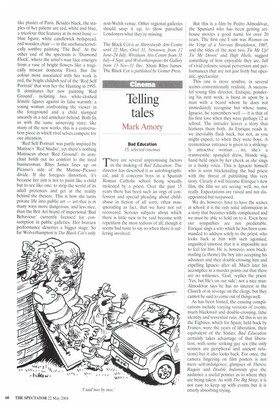Not nice
Laura Gascoigne
Shani Rhys James: The Black Cot Aberystwyth Arts Centre, until 22 May
Last year, after Shani Rhys James won the Jerwood Painting Prize, I showed examples of her work to a friend. 'Oh!' she said, taken aback. 'They're not nice.' Fifty years of feminism don't seem to have changed much. For contemporary British women painters there are still two approved routes to artistic success: if figu
rative, to stick to decorative domestic subjects; if abstract, to splash out in big, bold, optimistic colour.
Shani, Rhys James refused to take either route when, as a figurative art student in the 1970s, she stubbornly enrolled at an 'abstract' art school, St Martins. Professionally, her decision has been proved right by the number of major awards she has since collected: the Gold Medal for Fine Art at the Eisteddfod in 1992, the Hunting Art Prize in 1993 and the Jerwood. Now she has returned to Aberystwyth Arts Centre, the scene of her first triumph in the 1989 Wales Open, for the start of a touring exhibition of recent paintings coinciding with the publication of The Black Cot, the first book on her work, by Edward Lucie Smith.
'Welsh painter' is another art world pigeonhole in which Rhys James has been rather arbitrarily put. Although her father was Welsh by birth, she was born in Australia, coming to London with her actress mother in the 1960s and only moving to rural Wales in the mid-1980s to get her two young sons out of the East End of London. The change of scene brought a surprising change of direction. Instead of doing the obvious and painting the Welsh landscape, she turned her attention inwards on family life.
Her first paintings to come out of Wales were haunting interiors from which the pallid faces of mother and sons stare out, confined and defined by domesticity. Then came a series of claustrophobic studio selfportraits and recollections of a theatre childhood where empty costumes stand in loco parentis. Whatever the subject, the style is unmistakable. Sticky paint is savagely smeared, scuffed, scored and scraped on to canvas, chafing the figures' flesh and giving their eyes a bright glassy stare. Apart from the self-portrait heads, of which there are five in the show, the pictures are unusually large, especially for an artist barely over 5ft. The sphere may be domestic, the ambition is not. 'I paint things big,' says Rhys James, 'because they are for the public.'
The biggest painting in this show, 'Black Cot & Latex Glove', is nearly 12ft high and, it must be said, not nice at all. On the bars of the cot an imperious red-faced infant has pulled itself up to fix us with a beady glare. Its smock is white, the wall behind is white, and on the black floor under the cot is a white rubber glove. Like that of the cot itself, suggesting imprisonment or protection, the symbolism of the glove is ambiguous. It could be surgical — and sinister — or domestic — and reassuring. Typically of Rhys James, it is both and neither. It's a professional signature: one of the surgical gloves she wears for painting since her father — a surgeon — warned her of the dangers of lead white.
Rhys James uses an awful lot of white, building it up to a juicy texture like butter icing or letting it dry to a chalky surface like plaster of Paris. Besides black, the staples of her palette are red, white and blue, a tricolour that features at its most basic — blue figure. white candlewick bedspread, red wooden chair — in the uncharacteristically sombre painting 'The Bed'. At the other end of the spectrum is 'Diamond Flock', where the artist's wan face emerges from a vase of bright flowers like a tragically miscast domestic Flora. But the colour most associated with her work is red, the bright childish red of the 'Red Self Portrait' that won her the Hunting in 1993. It dominates her new painting 'Red Ground', isolating two white-clothed female figures against its false warmth: a young woman confronting the viewer in the foreground and a child slumped uneasily in a red armchair behind. Both fix us with the same unnerving stare: like many of the new works, this is a conversation piece in which rival selves compete for our attention.
'Red Self Portrait' was partly inspired by Matisse's 'Red Studio', yet there's nothing Matissean about 'Red Ground': its armchair holds out no comfort to the tired businessman. Rhys James lines up on Picasso's side of the Matisse-Picasso divide. If she foregoes distortion, it's because her aim is not to paint like a child but to see like one: to strip the world of its adult pretences and get at the reality behind the theatre. This is how she turns private life into public art — art that is in many ways more dangerous, and less nice, than the Brit Art brand of impersonal 'Bad Behaviour' currently licensed for consumption in public galleries. Her bravura performance deserves a bigger stage. So far Wolverhampton is The Black Cot's only non-Welsh venue. Other regional galleries should snap it up, to show parochial Londoners what they're missing.
The Black Cot is at Aberystwyth Arts Centre until 22 May; Oriel 31, Newtown, from 12 June-24 July; Wrexham Arts Centre from 31 July-4 Sept; and Wolverhampton Art Gallery from 13 Nov-31 Dec. Shani Rhys James: The Black Cot is published by Gomer Press.



















































































 Previous page
Previous page